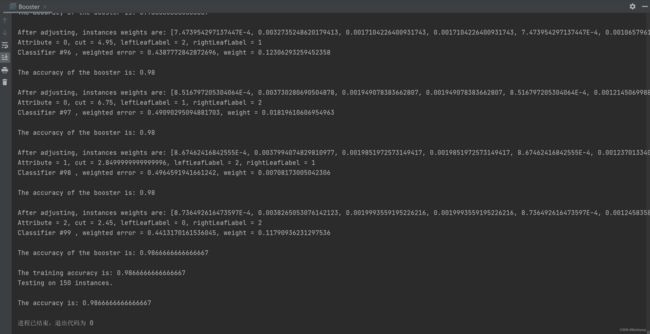Day 65: 集成学习之 AdaBoosting (3. 集成器)
代码:
package dl;
import java.io.FileReader;
import weka.core.Instance;
import weka.core.Instances;
/**
* The booster which ensembles base classifiers.
*/
public class Booster {
/**
* Classifiers.
*/
SimpleClassifier[] classifiers;
/**
* Number of classifiers.
*/
int numClassifiers;
/**
* Whether or not stop after the training error is 0.
*/
boolean stopAfterConverge = false;
/**
* The weights of classifiers.
*/
double[] classifierWeights;
/**
* The training data.
*/
Instances trainingData;
/**
* The testing data.
*/
Instances testingData;
/**
******************
* The first constructor. The testing set is the same as the training set.
*
* @param paraTrainingFilename
* The data filename.
******************
*/
public Booster(String paraTrainingFilename) {
// Step 1. Read training set.
try {
FileReader tempFileReader = new FileReader(paraTrainingFilename);
trainingData = new Instances(tempFileReader);
tempFileReader.close();
} catch (Exception ee) {
System.out.println("Cannot read the file: " + paraTrainingFilename + "\r\n" + ee);
System.exit(0);
} // Of try
// Step 2. Set the last attribute as the class index.
trainingData.setClassIndex(trainingData.numAttributes() - 1);
// Step 3. The testing data is the same as the training data.
testingData = trainingData;
stopAfterConverge = true;
System.out.println("****************Data**********\r\n" + trainingData);
}// Of the first constructor
/**
******************
* Set the number of base classifier, and allocate space for them.
*
* @param paraNumBaseClassifiers
* The number of base classifier.
******************
*/
public void setNumBaseClassifiers(int paraNumBaseClassifiers) {
numClassifiers = paraNumBaseClassifiers;
// Step 1. Allocate space (only reference) for classifiers
classifiers = new SimpleClassifier[numClassifiers];
// Step 2. Initialize classifier weights.
classifierWeights = new double[numClassifiers];
}// Of setNumBaseClassifiers
/**
******************
* Train the booster.
*
* @see algorithm.StumpClassifier#train()
******************
*/
public void train() {
// Step 1. Initialize.
WeightedInstances tempWeightedInstances = null;
double tempError;
numClassifiers = 0;
// Step 2. Build other classifiers.
for (int i = 0; i < classifiers.length; i++) {
// Step 2.1 Key code: Construct or adjust the weightedInstances
if (i == 0) {
tempWeightedInstances = new WeightedInstances(trainingData);
} else {
// Adjust the weights of the data.
tempWeightedInstances.adjustWeights(classifiers[i - 1].computeCorrectnessArray(),
classifierWeights[i - 1]);
} // Of if
// Step 2.2 Train the next classifier.
classifiers[i] = new StumpClassifier(tempWeightedInstances);
classifiers[i].train();
tempError = classifiers[i].computeWeightedError();
// Key code: Set the classifier weight.
classifierWeights[i] = 0.5 * Math.log(1 / tempError - 1);
if (classifierWeights[i] < 1e-6) {
classifierWeights[i] = 0;
} // Of if
System.out.println("Classifier #" + i + " , weighted error = " + tempError + ", weight = "
+ classifierWeights[i] + "\r\n");
numClassifiers++;
// The accuracy is enough.
if (stopAfterConverge) {
double tempTrainingAccuracy = computeTrainingAccuray();
System.out.println("The accuracy of the booster is: " + tempTrainingAccuracy + "\r\n");
if (tempTrainingAccuracy > 0.999999) {
System.out.println("Stop at the round: " + i + " due to converge.\r\n");
break;
} // Of if
} // Of if
} // Of for i
}// Of train
/**
******************
* Classify an instance.
*
* @param paraInstance
* The given instance.
* @return The predicted label.
******************
*/
public int classify(Instance paraInstance) {
double[] tempLabelsCountArray = new double[trainingData.classAttribute().numValues()];
for (int i = 0; i < numClassifiers; i++) {
int tempLabel = classifiers[i].classify(paraInstance);
tempLabelsCountArray[tempLabel] += classifierWeights[i];
} // Of for i
int resultLabel = -1;
double tempMax = -1;
for (int i = 0; i < tempLabelsCountArray.length; i++) {
if (tempMax < tempLabelsCountArray[i]) {
tempMax = tempLabelsCountArray[i];
resultLabel = i;
} // Of if
} // Of for
return resultLabel;
}// Of classify
/**
******************
* Test the booster on the training data.
*
* @return The classification accuracy.
******************
*/
public double test() {
System.out.println("Testing on " + testingData.numInstances() + " instances.\r\n");
return test(testingData);
}// Of test
/**
******************
* Test the booster.
*
* @param paraInstances
* The testing set.
* @return The classification accuracy.
******************
*/
public double test(Instances paraInstances) {
double tempCorrect = 0;
paraInstances.setClassIndex(paraInstances.numAttributes() - 1);
for (int i = 0; i < paraInstances.numInstances(); i++) {
Instance tempInstance = paraInstances.instance(i);
if (classify(tempInstance) == (int) tempInstance.classValue()) {
tempCorrect++;
} // Of if
} // Of for i
double resultAccuracy = tempCorrect / paraInstances.numInstances();
System.out.println("The accuracy is: " + resultAccuracy);
return resultAccuracy;
} // Of test
/**
******************
* Compute the training accuracy of the booster. It is not weighted.
*
* @return The training accuracy.
******************
*/
public double computeTrainingAccuray() {
double tempCorrect = 0;
for (int i = 0; i < trainingData.numInstances(); i++) {
if (classify(trainingData.instance(i)) == (int) trainingData.instance(i).classValue()) {
tempCorrect++;
} // Of if
} // Of for i
double tempAccuracy = tempCorrect / trainingData.numInstances();
return tempAccuracy;
}// Of computeTrainingAccuray
/**
******************
* For integration test.
*
* @param args
* Not provided.
******************
*/
public static void main(String args[]) {
System.out.println("Starting AdaBoosting...");
Booster tempBooster = new Booster("C:\\Users\\86183\\IdeaProjects\\deepLearning\\src\\main\\java\\resources\\iris.arff");
tempBooster.setNumBaseClassifiers(100);
tempBooster.train();
System.out.println("The training accuracy is: " + tempBooster.computeTrainingAccuray());
tempBooster.test();
}// Of main
}// Of class Booster结果:
